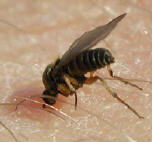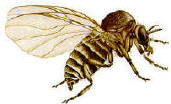Flies That Love Humans
(6/9/2000)
When you decode the Greek construction of "anthropophilic," it sounds like a
good thing: "human loving." When the term is applied to biting insects, however,
anthropophilic takes on a more annoying, or even sinister, connotation.
Some of the most annoying, if not quite sinister, of biting insects, are the
black flies that love human beings in the late spring and early summer in North
America.  There
are more than 40 species of black flies on the continent. Not all are
anthropophilic. One species, for example, has never been found on anything but
loons. Other species are generalists that will prey on any blood-carrying
creatures, including humans.
There
are more than 40 species of black flies on the continent. Not all are
anthropophilic. One species, for example, has never been found on anything but
loons. Other species are generalists that will prey on any blood-carrying
creatures, including humans.
Black flies lay their eggs in the flowing water of streams and rivers. The
larvae that hatch from the eggs attach themselves to rocks and plants in the
stream bed, where they feed on detritus, bacteria, and algae and just about
anything else they can filter out of the water flowing past them. As adults,
virtually all black fly species get nourishment from flower nectar. Males feed
exclusively on nectar.
Females of many black fly species, however, require the protein from a blood
meal in order to form and lay eggs. When they are in a maternal mood, they
sample the breezes for excess carbon dioxide, a sure sign of animal respiration.
Following the trail of carbon dioxide and breath odors, they track down their
intended victim.
Once they get within about 15 or 20 feet, the flies switch to visual mode and
home in on a landing site. As they get closer, black flies sense the heat of
their prey. Once the fly lands, it switches back to its sense of smell to
determine whether it is in a good location for blood.
All this loving of humans is not applied universally. Some people claim they
are unusually affected by black flies ... or unusually loved, I suppose.
Research done by Dr. James Sutcliffe, an entomologist at Trent University in
Ontario, is proving them right. By stationing brave volunteers in a field and
counting the black flies that descend on them, Dr. Sutcliffe and his student,
Steve Schofield, have documented the fact that some people truly are more
lovable to black flies. The reason seems to be largely that those people exhale
more carbon dioxide than most. With every breath, they advertise, "Here I am!"
Dr. Sutcliffe, and many other researchers around the world, are trying to
figure out exactly how black flies and other biting insects find their victims,
so they can thwart the process. Fighting black flies is a big deal, affecting
the economics of farming and springtime tourism in parts of Canada and the
United States. When female black flies go looking for blood in swarms, they are
annoying in the extreme. In some parts of Canada, black flies can be so thick
and relentless that they drive cattle and dairy cows to distraction. Because
harassed bovines may not eat enough to put on weight, black flies are a major
factor in determining the northern limits of livestock farming in Canada.
Black flies in North America are not known to transmit any diseases to human
beings, but in other parts of the world, the flies' love for humans is more
destructive. Onchocerciasis, also called River Blindness, is a disease caused by
a parasitic worm carried by black flies in Africa and parts of Latin America. As
its common name suggests, onchocerciasis can cause blindness. Millions of people
are affected by the disease, and fear of it leads to the abandonment of large
areas of fertile land near rivers.
Because of the health and economic impact of black flies, many methods of
control have been developed in this century. The most effective is probably the
application of DDT to rivers and streams to kill the larvae before they turn
into biting adults. Though DDT is banned in the United States because of its
widespread toxicity and persistence in the environment, it is still used in
Africa. Pesticides that are more specific to black flies and less harmful to
"non-target" species have been developed and are also in widespread use in
Africa and North America.
About twenty-five years ago, a bacteria was discovered in Israel that has
extraordinary effect on black fly and mosquito larvae. This bacteria is a
special form of Bacillus thuringiensis, commonly called Bt and used to control
insects in agriculture and backyard gardens. Application of the special strain
of Bt to streams typically causes the death of more than 95% of black fly larvae
within a day or so. This "biological" control is much more environmentally
friendly than chemical pesticides like DDT. The bacterial pesticide has little
or no direct effect on fish, amphibians or other aquatic insects and is
economically competitive with pesticide application. It also disappears rapidly.
For these reasons, the Bt pesticide is now widely used in North America to
control black flies and mosquitoes. It's hard to argue against the idea that the
use of Bt to control biting flies represents progress, compared to DDT. But I
wonder about the long-term wisdom of such an aggressive battle against black
flies.
I probably won't win any friends by being "black fly- philic," but they are
an important component of ecosystems. Adult black flies, when they aren't biting
people, are significant pollinators of many flowering plants. In many streams,
black fly larvae are the most numerous insects, sometimes found in densities of
a million larvae per square meter. They play a key role in recycling plant and
animal detritus. They are in turn a major source of food for fish, dragonfly larvae and
other aquatic predators. One multi-year study of Bt use on mosquito larvae in
Minnesota wetlands showed that while other aquatic creatures were largely
unaffected in the first year of application of Bt, the repeated elimination of
mosquito larvae over several years changed the fauna of the wetlands in
significant ways. It seems likely that similar results would be found for black
fly larvae treatment in streams.
detritus. They are in turn a major source of food for fish, dragonfly larvae and
other aquatic predators. One multi-year study of Bt use on mosquito larvae in
Minnesota wetlands showed that while other aquatic creatures were largely
unaffected in the first year of application of Bt, the repeated elimination of
mosquito larvae over several years changed the fauna of the wetlands in
significant ways. It seems likely that similar results would be found for black
fly larvae treatment in streams.
So maybe we should think again about large scale control efforts, at least in
areas where black flies don't cause human disease. Researchers like Dr.
Sutcliffe are trying to find ways to attract and trap biting flies in specific
areas where they cause major problems, such as pastures. For example, one highly
anthropophilic species of mosquito in Africa is attracted to the odor of smelly
feet. It is also -- as silly as this sounds -- attracted to Limburger cheese. It
turns out that the bacteria that cause foot odor are very closely related to the
bacteria that turn milk into Limburger cheese, and they give off a similar
smell. Traps baited with the cheese, or with isolates of the cheese odor, may
someday reduce the biting of humans. Other studies are developing more effective
repellents to protect livestock and people. These efforts seem to me to be a
more environmentally safe source of relief.
As for personal relief, the next time you are in an outdoor crowd and the
black flies seem to be singling you out for their human lovefest, remember, they
are attracted most of all to carbon dioxide. So run like crazy, but don't forget
to hold your breath.